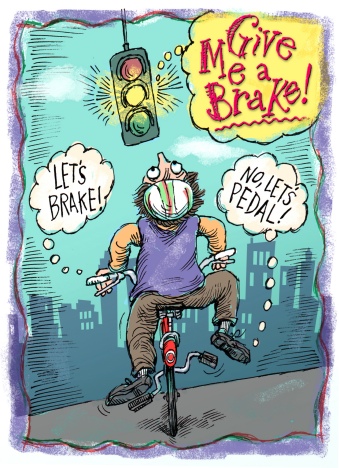[Publisher’s note: Welcome to Bike Law 101, a new column written for BikePortland by Kurt Jansen. Kurt is the Executive Director of the Animated Traffic Law Center. ATLC is a Eugene, Oregon based non-profit that helps organizations with their traffic law education efforts (the City of Portland hired them to create the “Every Corner is a Crosswalk” animation). Each month, Kurt will tackle a tricky bike law with hopes of adding some clarity to a our vehicle code.]
Entering an intersection on a solid yellow light is illegal in Oregon unless you cannot stop in time safely.
It’s a familiar enough scene. You’re on your bike approaching an intersection and the light is green. But, it’s been green for a while now; any second it will go to yellow (or perhaps it already has). Signal engineers call this the “dilemma zone.” Do you blast into the intersection or do you restrain yourself, slow down and wait?

Here’s one answer. ORS 811.260 deals with, “Appropriate driver responses to traffic control devices.” In subsection 3, it states:
(3) Steady circular yellow signal. A driver facing a steady circular yellow signal light is thereby warned that the related right of way is being terminated and that a red or flashing red light will be shown immediately. A driver facing the light shall stop at a clearly marked stop line, but if none, shall stop before entering the marked crosswalk on the near side of the intersection, or if there is no marked crosswalk, then before entering the intersection. If a driver cannot stop in safety, the driver may drive cautiously through the intersection. (A “driver” as used in this statute is also considered a bicyclist. 811.400(1)(a))
The law is clear. Entering an intersection on a solid yellow light is illegal in Oregon unless you cannot stop in time safely. What “…stop in time safely” means depends on the officer’s opinion of whether or not you had the time to do so. This clause, “…cannot stop in time safely,” is not a get-out-of-jail-free card for failure to use the brakes. Rather, implicit in this statute is a driver’s ability and responsibility to control their vehicle’s speed so as to stop safely before entering an intersection on a solid yellow.
Are you willing to bet your life you’ll cross the entire intersection before the light goes red?
If you are traveling so quickly that stopping would send you over the handlebars, or the road is slick and you may prohibit your ability to stop safely before entering the intersection, you may qualify as the exception.
There is, of course, a larger consideration. Are you willing to bet your life you’ll cross the entire intersection before the light goes red? You should know that 33% of all bicycle and motor vehicle crashes happen in intersections.
You may be competing directly with a motor vehicle operator coming from behind who is as focused on the signal as you are and is hoping to make a right hand turn before it changes. Or there may be someone in the far right lane of the opposing traffic that sees the light is changing and may not be slowing down or looking at cross traffic.
If you still decide the risk is worth it, here’s one more thought. On average, the light will go from yellow to red on the 4th second. If you are traveling at 12mph and crossing 5 – 12 foot lanes or 60 feet of road, you are covering 17.6 feet a second. In the 3 seconds of yellow grace, you’ll cover 52.8 feet making it almost all the way across.
The choice is always situational and personal. As you near a stale green light, the pedestrian signals, if activated, do offer a good guideline for the possibility of crossing. As long as the walking figure appears or the red hand is flashing, your light will stay green. A pedestrian signal that counts down is even better, but once the hand goes to solid red, the traffic signal is about to change and should help inform your judgment. The goal is to avoid damage, crashes, injuries or fatalities.
As always, it’s up to you.

